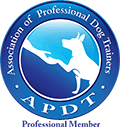Archive OLDT :: The Tao of Training
Many of my clients wonder why their pups are transfixed by me, even as they offer the very same treats that I do; why their pups follow me with rapt attention while they stall and sputter with their parents. Well, I’m about to reveal some of the mystery and the magic of dog training -– the tao of it. The key to the mystery of dog training is that I make training no mystery to the dog. I am clear about what I want, I make it easy enough for him to succeed, and I reinforce highly for a job well done. Well, here’s how to do it…Management Techniques
First, you need to set your dog up to succeed without too much trouble. If his tasks are not made simple enough at the start, he’s liable to get frustrated and be turned off to training altogether. Management techniques can help with this:- Your dog’s leash is a great management tool. With your dog on leash, hold the leash’s handle in one hand, letting the middle of the leash drag. Now step on the leash at a distance from your dog so that he can sit or stand comfortably but cannot jump up. I call this control position. When you’re in the bank, when you’re on an elevator, when you stop to talk to someone in the street, assume control position. This way you know that he can’t jump up on people, no matter how excited he gets, and you also know that, if you get distracted with other things, he can’t get into any trouble. He’s riveted to his spot!
- Humans are space sensitive – you know how uncomfortable you are with people who are close talkers. Well, dogs are very sensitive to the use of space, too! So, when dogs jump up on us, crowd the entry of a visitor at the door, or even invade our personal space when we’re seated, it is an intentional behavior – your pup knows it’s pushy to invade our personal boundary. Use your body to block access to this space by stepping into him and moving him back to a polite distance before returning to your position. Keep stepping him back until he holds himself at the more polite distance.
Understanding Motivators
It’s just common sense… if you don’t know what your dog’s motivators are, then you have nothing that will inspire him to want to learn.- Know what is reinforcing and have control of it at any given time: food, toys, affection, walks. And remember: a given reward is not always reinforcing. Petting and loving may only be an annoyance to a hungry dog.
- Use deprivation of a particular motivator in order to make it more desirable and more motivating. Train with treats before a meal, not after your dog is full. Or if your dog will work hard for some play with a squeaky toy, make sure that he hasn’t been playing with it all day on his own.
- Employ variety: A dog who’s been getting hotdogs may step up performance for a nibble of cheese.
- Understand the hierarchy of desirability of reinforcers: Most dogs won’t work as hard for kibble as they will for chicken or steak.
- Use the environment. Food is not the only agent of rewarding or reinforcing a behavior. When on a walk, often the surrounding environment can be even more interesting than food. To a dog intent on moving things, nothing will be more rewarding than being allowed to chase a napkin being carried by the wind! If your pup wants to greet a dog or sniff a tree, don’t allow him to pull towards it; instead ask him to perform a behavior, like a sit, down, touch, shake, anything. When he does it, say, “OK, go [say hi/sniff/etc!]”. If he doesn’t, then say, “Too bad!” and turn away. You are the master of the environment and can grant or deny its access.
- Some dogs find it difficult to attend to their handlers in the company of dogs, people, or other distractions (like cats or birds). They are too transfixed by the distraction to listen to commands or tear their attention away. I call this the gravitational pull of that distractor. You need to keep a distance from the distractor where your gravitational pull is stronger than that of the distractor.
Training Principles
A cursory understanding of some basic training principles will make the training process more effective and more enjoyable.- Don’t assume knowledge, a mistake which will only frustrate you and your dog! For instance, many people assume that their dog knows sit because when they say the word and look purposefully at the dog, he sits. But many a dog is smart enough to figure out that his owner loves when he sits, and so he will do it in response to just about any command. So, to check your dog’s knowledge, use another word, like “spaghetti”. If he still sits, then it’s clear he is not distinguishing the sit cue from any other. You need to go back to square one, using the command (either hand signal or verbal cue), then marking and treating for a successful performance of the behavior.
- The best way to inhibit undesirable behaviors is to train a DRI (Differential Reinforcement of an Incompatible) behavior. So, to eliminate an undesirable behavior, picture in your head a preferred behavior, if possible one that cannot happen simultaneously with the undesirable behavior, and train your dog to do that instead. For instance, instead of jumping up in greeting, wouldn’t you prefer if your dog sat?!
- As you make one aspect of an exercise more difficult, you should drop your expectations of another aspect. For instance, when working on a stay, as you increase the distraction of people moving around, you need to increase the frequency of reinforcement (thus decreasing duration). Or, as you increase your distance from your pup, you need to decrease distraction by moving from the yard back into the house. So what’s an example of a huge change in distraction?! – taking your training on the road! While you might get a down-stay with very occasional treats in the house, a down-stay out on the street, with passing people, dogs and other lovely distractions will require higher value treats at a much higher rate of reinforcement!
- All too often, people complain that their dog needs to see the treat in order to be motivated to work. This says to me that there is a huge difference between the training environment and the normal, everyday environment – that there are indicators that communicate to the dog that treats are in the offing (i.e. a treatbag, a bulging pocket, etc). Remember that every moment of the day needs to be a potential training situation. And this includes working outside. Too often people don’t take treats with them on the street because it’s unwieldy and an annoyance. If you were the dog, wouldn’t you quickly learn to work for pay inside but feign hard-of-hearing outside?!
- Include others in training so that your dog learns to generalize, so that sit means sit regardless of who tells him. Further, by involving children in the training process, your dog learns to respect little people as well as big.
-
Many dog trainers espouse the principle of Nothing In Life Is Free (NILIF) – that the dog needs to work for everything he deems valuable. This means food, toys, affection, access to furniture, going for walks, everything! Personally, I find this a pretty difficult principle to live by with my own dog and, if I can’t do it, I can’t possibly expect my clients to.
How strictly you adhere to NILIF depends on your dog. A dog who is pushy and demanding and disrespectful of others’ space should have a more strict NILIF structure than a dog who is polite, respectful and compliant. But most importantly, nothing good should be granted for undesirable behavior.
The Devil in the Details
- Timing is essential when training: praise or punishment needs to occur within one second of the behavior to be most effective, and punishment should ideally be impersonal, which makes it difficult to deliver effectively (see my article When Considering Using Punishment).
- Pace is another component of efficient training. Rapid-fire repetitions keep your dog engaged and less likely to get distracted or bored, so use small, soft treats that can be quickly consumed.
- Vocal intonation and tempo are innately understood. High noises are pleas for attention, either for assistance or affiliation; low noises are used in warning or to increase distance. Staccato noises encourage activity; soft, soothing noises are calming. So, when you’re trying to tempt your puppy to walk with you, use high happy chirps to invite him along. But such a voice would be counter-productive when training a sit-stay.
- Touch is equally powerful. Long, slow strokes are more calming than short, fast pats or slaps. Many a dog parent can’t understand why their pup gets mouthy and playful when being petted, not realizing that the tenor of their physical contact can have a lot to do with it.
Mental Stimulation
- It’s common knowledge that a tired dog is a good dog – that exercise is essential. But be aware that mental stimulation is just as important a component of a dog’s well-rounded life. Training is one way that you can challenge him mentally. Using puzzle toys for your dog’s meals and snacks are a great way to provide mental stimulation, like Puppy Sudoku! And playing with your dog inside is no substitute for the important mental stimulation provided by outdoor excursions, where there are new sights, sounds, and experiences.
The Dominance Myth and Misnomer
The term dominance has developed into a catch-all for characterizing just about every undesirable behavior our dogs practice – from jumping on people in greeting to barking for attention and lunging at other dogs on the street. It has become our excuse for behavior that is really just that of a poorly trained dog.This wrestling that we’re doing with the question of dominance is perhaps the single greatest threat to our relationships with our dogs. And the things we do in the name of asserting our dominance mar the loving fabric we have woven together with them.
Because dominant behavior is so rarely the underlying cause of behavior problems, we should challenge ourselves to leave the word dominance out of our vocabulary entirely, and instead compel ourselves to identify the true root issues. Our relationships with our dogs would undoubtedly be the better for it.




